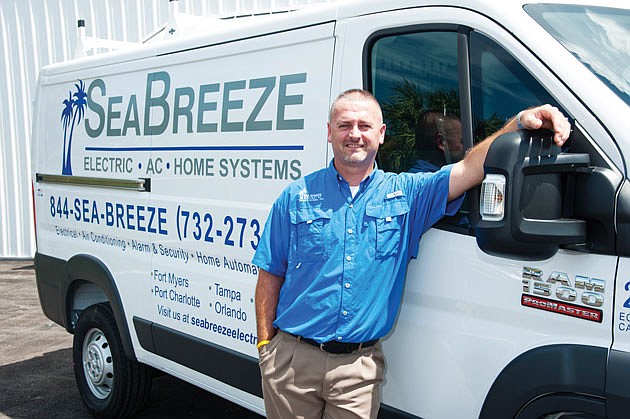- April 16, 2024
-
-
Loading

Loading

Wiring a home is all about making connections. For electric and related services company SeaBreeze Electric Inc., the connections it's forged outside the home have proved just as important as those made within the walls.
“Our growth has all been relationship driven,” says Sean Jenkinson, the company's president. “We don't advertise. Relationships, to me, are your best friend.”
SeaBreeze, which celebrated its 20th anniversary last year, recently moved into a new headquarters in Port Charlotte. Since 2010, it's grown from about 50 employees and about $7 million in revenue to more than 350 employees and $39.4 million in revenue in 2016. Hitting close to $50 million, executives say, is a possibility in 2017.
Jenkinson, with the firm since its early days, now has an ownership stake in the business. SeaBreeze CFO Randy Besosa and a behind-the-scenes partner bought the company in 2013.
Expansion has helped drive growth, both in geography and service offerings. The company was founded in Fort Myers. Its Port Charlotte location came about five years later, followed by Vero Beach, Tampa and then Orlando.
Those moves were fueled by the firm's relationships with major homebuilders — the bulk of SeaBreeze's customer base. When builders are satisfied with the company's work, they ask it to follow them to new projects.
“Most of the national builders have such a stringent schedule to build these homes,” says Jenkinson. “We've taught ourselves over the years how to adjust, how to adapt. You only have a certain amount of time to perform a task, and we're able to hit those parameters.”
Homebuilders are also why the company began to offer services beyond electrical wiring. After about seven years, it started doing alarm, security system and home theater installations. In the past two years, it's also added air-conditioning repair and replacement, and is doing more with home automation — a growing industry trend.
One business line the company probably won't be getting into: plumbing. Though many peers in the industry tend to add this service, SeaBreeze has decided it doesn't fit as well with everything it's already doing, especially since home automation is only just starting to take off.
“With home automation, you don't control your faucet,” says Besosa. “But you do control your AC, your lights and your security camera.”
The company's growth isn't going unnoticed. In 2016 it made the Engineering News-Record's list of Top 600 Specialty Contractors in the U.S. And it recently got word that it made the 2017 Inc. 5000 list of the fastest-growing companies nationwide.
“These are some big milestones for the company coming after 20 years in the business,” says Besosa. “It takes a lot of time, perseverance and, most importantly, teamwork to get there.”
Offering a variety of services from five locations does come with some challenges. Managing people and inventory in different offices statewide is a big one.
“You move into needing systems and controls, to investing $500,000 in accounting systems and software,” says Besosa. “But you make the human and capital investments required. And then you take your lumps along the way. You have startup costs; a new location doesn't turn a profit until it gets its feet and volume. It's not for the faint of heart.”
Having the right people in place to oversee the processes and systems is key. SeaBreeze, say executives, is willing to spend the money needed to retain and train its employees. It offers a comprehensive benefits package that includes a 401(k) plan in which the company contributes; a variety of health insurance options — including plans for pets; and a rewards program where employees can get discounts at local restaurants and retailers.
“Our goal is to be the best place to work,” says Besosa.
That's important, since SeaBreeze faces the same labor challenges its competitors and homebuilder partners do. It sometimes has to hire less-experienced workers, which increases training costs. And it needs to deal with the labor differences in each market it works. Fort Myers, where the company has many second-generation employees, has never been much of a struggle. Port Charlotte is the company's toughest market to find employees.
But geographic diversity can also be an advantage. That's especially true when one geographic market is a down a bit, but another area is up. It protects the firm from being dependent on any one location, and allows it to shift workers around as needed.
Further geographic expansion is a possibility. That could be on its own or in following a homebuilder. “We would want to do it cost effectively and intelligently to make sure it happens the way it should,” says Jenkinson. “Our HVAC division wasn't something we did overnight; we started slowly. We'd known other companies that had done it and failed, and we wanted to make sure we didn't.”
While SeaBreeze already works with big-name builders like Lennar, Mattamy Homes, Pulte Homes and Taylor Morrison, there are plenty of builders out there it hasn't developed relationships with yet. And it sees homebuilding remaining strong over the next five to 10 years, with baby boomers retiring and millennials in the market for their first home.
Moving beyond just working with builders is the company's next step. It figures it's wired more than 25,000 new homes in its 20 years in business. That's 25,000 potential customers who might need a repair one day or want to upgrade their lighting or add an alarm. “We have the hardest part; we have the customer base that everyone is fighting for,” says Besosa. “The next phase is to then connect with them and say, 'We're here.' It's a great opportunity.”